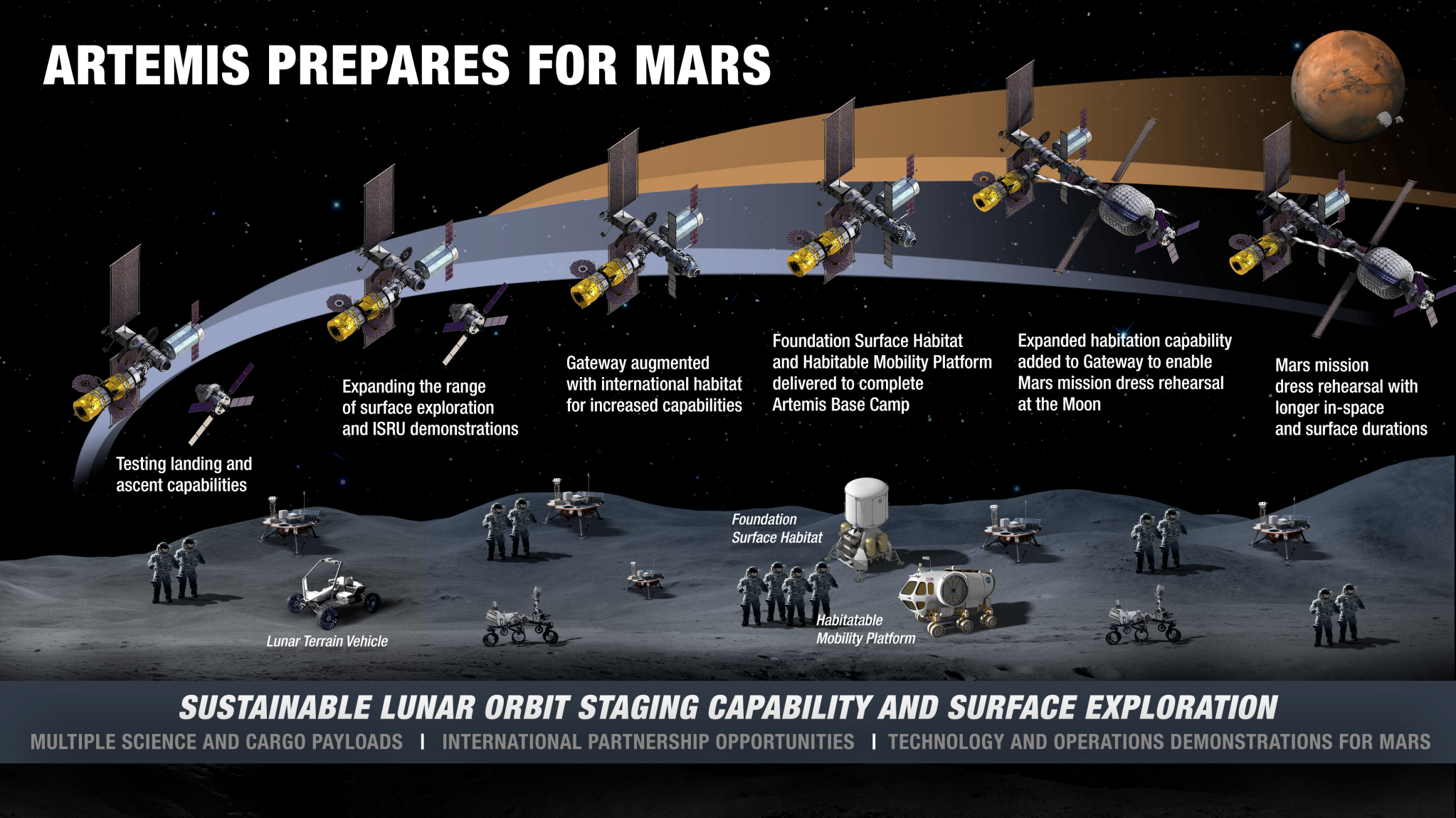When NASA sends astronauts to the surface of the Moon in 2024, it will be the first time outside of watching historical footage most people witness humans walking on another planetary body. Building on these footsteps, future robotic and human explorers will put in place infrastructure for a long-term sustainable presence on the Moon.
NASA recently proposed a plan to go from limited, short-term Apollo-era exploration of the 1960s, to a 21st Century plan in a report to the National Space Council. With the Artemis program, we will explore more of the Moon than ever before to make the next giant leap – sending astronauts to Mars.
“After 20 years of continuously living in low-Earth orbit, we’re now ready for the next great challenge of space exploration – the development of a sustained presence on and around the Moon,” said NASA Administrator Jim Bridenstine. “For years to come, Artemis will serve as our North Star as we continue to work toward even greater exploration of the Moon, where we will demonstrate key elements needed for the first human mission to Mars.”
On the surface, the core elements for a sustained presence would include an emphasis on mobility to allow astronauts to explore more of the Moon and conduct more science:
- A lunar terrain vehicle or LTV, would transport crew around the landing zone
- The habitable mobility platform would enable crews to take trips across the Moon lasting up to 45 days
- A lunar foundation surface habitat would house as many as four crew members on shorter surface stays
Astronauts working on the lunar surface also could test advanced robotics, as well as a wide set of new technologies identified in the Lunar Surface Innovation Initiative, focusing on tech development in the areas such as of in-situ resource utilization (ISRU) and power systems. Rovers will carry a variety of instruments including ISRU experiments that will generate information on the availability and extraction of usable resources (e.g., oxygen and water). Advancing these technologies could enable the production of fuel, water, and/or oxygen from local materials, enabling sustainable surface operations with decreasing supply needs from Earth.
Another key difference from Apollo and Artemis will be use of the Gateway in lunar orbit, built with commercial and international partners. The lunar outpost will serve as a command and control module for surface expeditions and an office and home for astronauts away from Earth. Operating autonomously when crew is not present, it also will be a platform for new science and technology demonstrations around the Moon.
Over time, NASA and its partners will enhance the lunar Gateway’s habitation capabilities and related life support systems. Adding a large-volume deep space habitation element would allow astronauts to test capabilities around the Moon for long-duration deep space missions.
While the goal of Apollo was to land the first humans on the Moon, the Artemis program will use the Moon as a testbed for crewed exploration farther into the solar system, beginning with Mars. This is America’s Moon to Mars space exploration approach. A proposed multi-month split-crew operation at the Gateway and on the lunar surface would test the agency’s concept for a human mission to the Red Planet.
For such a mission, NASA envisions a four-person crew traveling to the Gateway and living aboard the outpost for a multi-month stay to simulate the outbound trip to Mars. Later, two crew members would travel to the lunar surface and explore with the habitable mobility platform, while the remaining two astronauts stay aboard Gateway. The four crew members are later reunited aboard the lunar outpost for another multi-month stay, simulating the return trip to Earth. This mission would be the longest duration human deep space mission in history and would be the first operational test of the readiness of our deep-space systems.
The report also highlights a robotic return to the surface beginning next year for scientific discovery. The Moon is a natural laboratory to study planetary processes and evolution, and a platform from which to observe the universe. NASA will send dozens of new science instruments and technology demonstrations to the Moon with its Commercial Lunar Payload Services initiative. Some of these robotic precursors, including the Volatiles Investigating Polar Exploration Rover or VIPER, will study the terrain, and metal and ice resources at the lunar South Pole.
The Space Launch System rocket, Orion spacecraft, human landing systems and modern spacesuits will round out the agency’s deep space systems. As part of the Artemis III mission, the first human expedition back on the Moon will last approximately seven days. NASA plans to send Artemis Generation astronauts on increasingly longer missions about once per year thereafter.
With strong support in NASA, America and its partners will test new technologies and reduce exploration costs over time. Supporting infrastructure including power, radiation shielding, a landing pad, as well as waste disposal and storage could be built up in the coming decades, too.
“The U.S. is still the only nation to have successfully landed humans on the Moon and spacecraft on the surface of Mars,” the report states. “As other nations increasingly move out into space, American leadership is now called for to lead the next phase of humanity’s quest to open up the future to endless discovery and growth.”
Read the full report:























